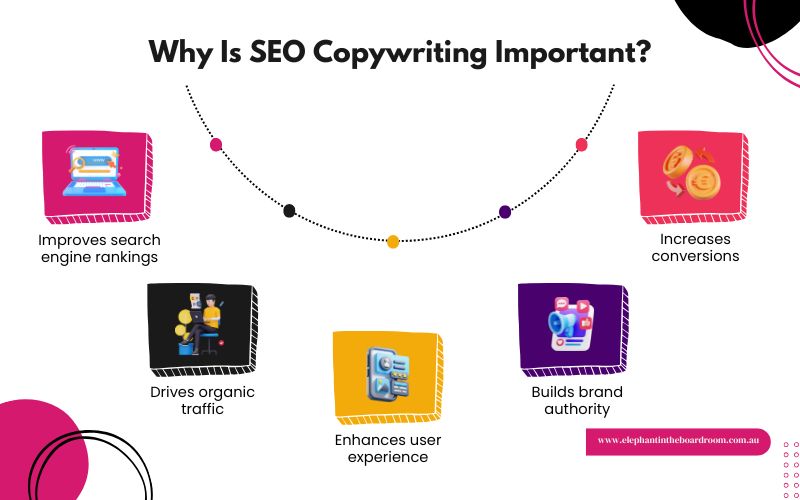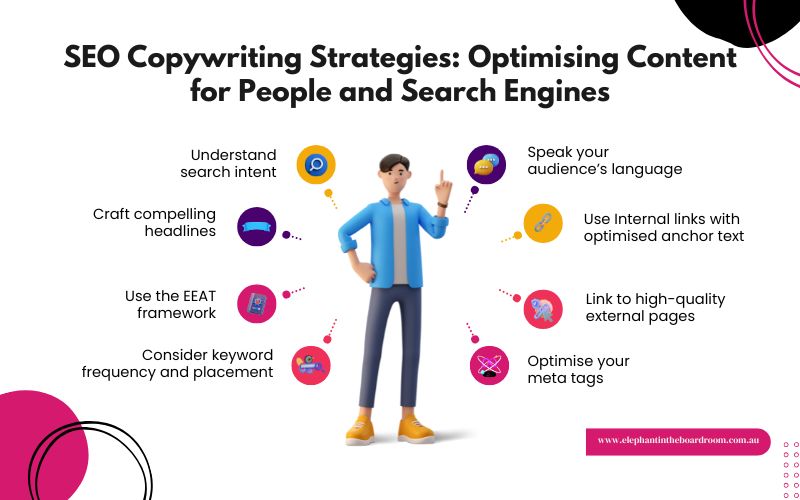
SEO Copywriting Strategies: Optimising Content for People and Search Engines
Google processes over 5.5 billion searches every single day, with 92% of web traffic going to results on the first page. This reality highlights the fierce competition for visibility in today’s digital landscape. To stand out, businesses and creators need more than just great ideas, they need SEO copywriting strategies that strike the perfect balance between appealing to search engines and engaging their audience.
If you are ready to boost your content's performance and climb the rankings, you are in the right place. We will explore SEO copywriting strategies that combine the technical know-how of optimisation with the art of persuasive storytelling. From writing content that resonates to implementing techniques that boost rankings, you will discover how to create work that not only gets found but also leaves a lasting impact.
What’s Inside:
- Traditional Copywriting vs SEO Copywriting
- Why Is SEO Copywriting Important?
- SEO Copywriting Strategies: Optimising Content for People and Search Engines
- Master SEO Copywriting Strategies for Success
Traditional Copywriting vs SEO Copywriting
Traditional copywriting and SEO copywriting serve distinct yet interconnected purposes. Traditional copywriting prioritises creativity, emotional resonance, and brand voice to make a lasting impression on the audience.
While maintaining those principles, SEO copywriting takes it a step further by optimising content for search engines. It is about blending compelling storytelling with strategic use of keywords and formatting techniques like headers, meta descriptions, and internal links. The goal is to rank higher in search engine results, increasing visibility and attracting organic traffic.
Both forms of copywriting aim to connect with readers, but SEO copywriting has the added layer of appealing to algorithms, ensuring that the content not only resonates with humans but also aligns with the technical requirements of online platforms.
Why Is SEO Copywriting Important?

SEO copywriting is important for businesses looking to improve their online visibility and attract more customers. Before we discuss SEO copywriting strategies, let's first explore why it's so important for your business success:
Improves Search Engine Rankings
SEO copywriting helps optimise content with the right keywords, making it easier for search engines like Google to find and rank your website higher.
Drives Organic Traffic
When you optimise your content with the right keywords and structure, you attract readers who are actively searching for solutions, products, or insights you offer. This means the traffic you drive to your website is not random, it is targeted, making it far more valuable.
Enhances User Experience
Good SEO copywriting isn't just about stuffing keywords into your content, it is about making it readable, useful, and appealing. Well-crafted, optimised content improves user engagement, keeps readers on your page longer, and encourages them to explore further.
Builds Brand Authority
Regularly publishing high-quality, keyword-optimised content positions your business as an authority in your field, boosting trust among potential customers.
Increases Conversions
By creating content that answers questions, solves problems, and includes strong calls to action, SEO copywriting helps turn website visitors into customers.
SEO Copywriting Strategies: Optimising Content for People and Search Engines

you begin crafting content, it is important to understand why people are searching for particular terms. What is driving their search? Are they seeking information, browsing for options, or ready to make a purchase?
Search intent generally falls into four main categories: informational, navigational, transactional, and commercial investigation.
- Informational Intent- This is when users are searching purely to learn something or gather knowledge, without any immediate plan to buy or take further action.
- Navigational Intent- Here, users are aiming to locate a specific website or page. They already know where they want to go but use search engines as a shortcut.
- Transactional Intent- When users have transactional intent, they are ready to take a specific action, whether it is making a purchase, signing up for a service, or downloading an app.
- Commercial Investigation Intent- These users are close to making a decision but are still weighing up their options. They might be comparing products, reading reviews, or hunting for the best deal.
Craft Compelling Headlines
Your headline serves as the first impression of your content, and it plays an important role in both user engagement and search engine ranking. To craft a headline that resonates with your audience and optimises for search engines, consider these key points:
- Be clear and informative- The headline should immediately communicate what the article is about while incorporating target keywords naturally.
- Spark curiosity or address a pain point- Headlines that promise a solution to a specific problem or offer a unique perspective tend to attract more clicks.
- Keep it under 60 characters- Headlines longer than 60 characters may get truncated in search engine results.
Let's have an example headline:
5 Ways to Grow Your Business in Australia Through Social Media
This headline is clear, informative, and to the point. It offers actionable tips ("5 Ways") and specifies the target audience (business owners in Australia). The mention of "Social Media" not only makes it relevant to current marketing trends but also targets a specific, high-volume keyword. It also stays within the optimal character length to ensure it isn't cut off in search results.
Use the EEAT Framework
This approach ensures your content is not only highly valued by search engines but also resonates with your audience. Here's how to leverage EEAT effectively:
- Demonstrate expertise- Showcase your knowledge of the subject matter by sharing accurate, insightful, and up-to-date information.
For example, If you are writing about personal finance, explain complex topics like "compound interest" in a simple yet authoritative way.
- Leverage real experience- Readers trust content grounded in real-life experience. Incorporating anecdotes, case studies, or personal stories can make your content more relatable and credible.
For example, writing a guide on renovating a kitchen? Share a personal or client example, such as how you chose cost-effective materials and overcame common challenges like unexpected plumbing issues.
Consider Keyword Frequency and Placement
Strategic keyword placement remains a cornerstone of SEO copywriting. Integrate primary keywords in key locations such as:
- Headlines- Ensure your headline conveys value while incorporating your target keyword.
- Subheadings- Break up your content with keyword-rich subheadings that improve readability.
- Opening paragraph- Include your keyword naturally within the first 100 words to establish topical relevance.
Speak Your Audience’s Language
Using terminology your audience understands is key. Avoid industry jargon unless you are addressing experts who value technical precision. Instead, focus on using clear, accessible language that aligns with their knowledge level and interests.
For example, if you are writing about fitness products for Gen Z, you wouldn’t say: "Our performance-enhancing supplements are formulated with cutting-edge bioactive compounds to optimise athletic recovery."
Instead, try: "Need faster recovery after your workouts? Our supplements are packed with natural ingredients to help your muscles bounce back, so you can hit it hard again tomorrow."
Gen Z appreciates clear, direct language that speaks to their lifestyle and concerns. They are often looking for products or tips that make their lives easier, more sustainable, or more fun.
Use Internal Links With Optimised Anchor Text
Guide readers through your site by linking to relevant pages using descriptive anchor text. Instead of using generic anchor text like "click here", use descriptive phrases that provide both context and value to your readers.
Instead of saying: "For more information about the best practices for website accessibility, click here."
You could write: "To discover the best practices for improving website accessibility and ensure your site is user-friendly for all visitors, check out our detailed guide.”
Link to High-Quality External Pages
Make sure the external sources you use are reliable and relevant. Search engines are informed that your content has been carefully examined when you link to reliable websites. Also, it benefits your viewers by offering more reliable resources.
For example, if your content discusses climate change, you could link to a government body or a well-established environmental organisation like The Australian Conservation Foundation or Climate Council.
Optimise Your Meta Tags
Your meta title and description are the first thing searchers see when they come across your page in search results. While meta tags themselves don’t directly impact rankings, they improve your click-through rates, which can indirectly influence your search engine performance.
For example, your meta title is "Website Audit Checklist for the New Year | Boost Your SEO in 2024"
Meta Description: Ready to kick off the new year with a fresh website audit? Our comprehensive checklist helps you optimise your site for better SEO performance and user experience in 2024. Start today!
By including targeted keywords like "Website Audit," "SEO," and "New Year," and offering a clear value proposition, these meta tags not only align with search intent but also encourage users to click through to your content.
Master SEO Copywriting Strategies for Success
Now that you've uncovered the strategies behind effective SEO copywriting, it is time to put them into action. From crafting engaging headlines to weaving in keywords seamlessly, each step you take towards optimising your content will make a significant difference in how your audience and search engines perceive your site. Consistency is key, so stay committed to refining your content, and soon you will notice your rankings climbing higher and your engagement levels soaring.
We are here to help you refine your SEO copywriting skills with the best SEO copywriting strategies and turn your digital presence into a powerhouse. Contact us today, and let’s start creating content that speaks to both your audience and search engines, driving sustainable traffic and long-term growth. Together, we can make your content work harder for you.



